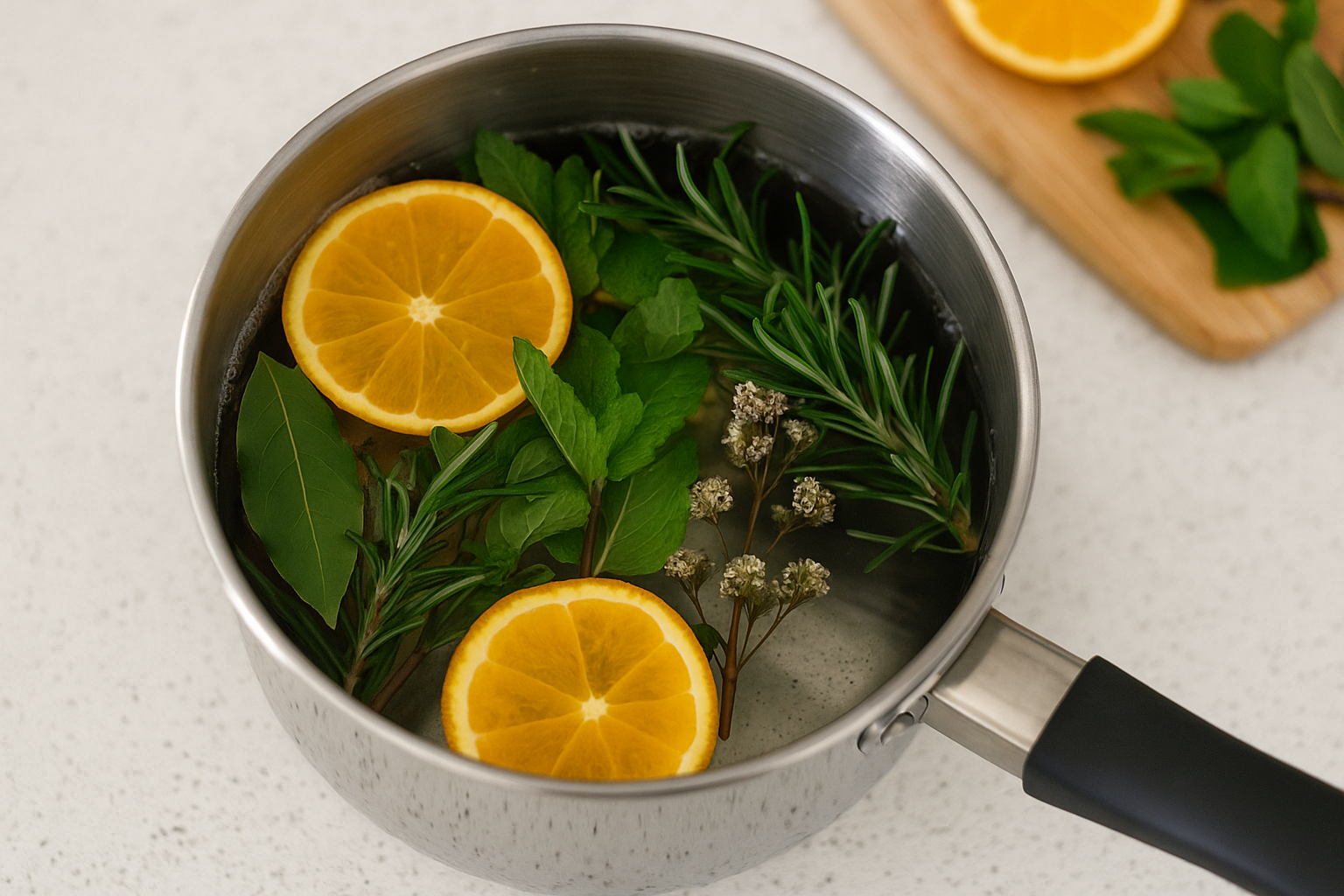Every home has its own smell. Cooking, pets, dampness, and dust all leave traces in the air.
Commercial air fresheners try to solve this with strong synthetic perfumes, but they only mask odors and often release chemicals that irritate lungs, trigger allergies, or pollute indoor environments.
A safer and more traditional alternative is the herbal simmer pot, an old method that uses nothing more than water, herbs, citrus, and spices.
A simmer pot is simple to prepare. You fill a pan with water, add chosen ingredients, and let it simmer gently on the stove. As steam rises, it carries fragrance into every corner of the house.
The effect is subtle but long-lasting, improving mood, refreshing air, and even adding humidity to dry rooms.
More than a cleaning trick, simmer pots are rituals of well-being. For many cultures, boiling herbs was a way to cleanse spaces and invite renewal.
This complete guide will show you why simmer pots work, which herbs and citrus are best, recipes for different moods and seasons, cultural meanings, mistakes to avoid, and answers to common questions.
By the end, you will know how to turn a pot of boiling water into a source of healing and comfort.
Why simmer pots work
Heat releases volatile oils from herbs and citrus. These aromatic compounds rise with steam and spread through the air. Unlike sprays or candles that depend on synthetic fragrance, simmer pots carry only natural plant molecules. Some, like rosemary and sage, contain antibacterial properties that reduce microbes. Citrus peels release limonene, which neutralizes odors and lifts mood. Spices like cinnamon or cloves add depth while also acting as mild purifiers. Together, they refresh indoor spaces in a safe, eco-friendly way.
Benefits of herbal simmer pots
They are natural and non-toxic, avoiding synthetic perfumes. They are affordable, often using kitchen scraps like orange peels. They are customizable: you can design blends for relaxation, focus, energy, or comfort. They humidify dry air, especially in winter. They reconnect us with traditional practices where fragrance was both functional and symbolic.
Key herbs, citrus, and spices
Rosemary sharpens focus, disinfects, and adds green freshness. Marcela is calming and traditional in Gaúcho culture, known for relaxation. Sage purifies and protects, both physically and spiritually. Mint refreshes and cools, helping clear the air. Lavender soothes and balances emotions. Orange uplifts and brings cheer. Lemon cleanses and deodorizes. Lime energizes and sharpens. Grapefruit invigorates and sweetens. Cinnamon comforts with warmth. Cloves purify with depth. Ginger stimulates with a spicy, fresh tone.
How to make a basic simmer pot
Fill a pot with two to three cups of water. Add a handful of fresh or dried herbs, citrus slices or peels, and a few spices. Bring to a boil, then reduce heat to simmer. Let it steam for hours, adding water as it evaporates. Adjust ingredients to taste and availability.
Recipes for mood boosting
Morning Energy Pot: lemon slices, rosemary sprigs, mint leaves. Afternoon Clarity Pot: orange slices, sage leaves, cinnamon stick. Evening Calm Pot: marcela flowers, lavender buds, chamomile tea bag.
Recipes for air purification
Antibacterial Fresh Pot: lemon slices, rosemary sprigs, cloves. Deodorizing Kitchen Pot: orange peels, mint leaves, ginger slices. Moisture Control Pot: lime slices, sage leaves, cinnamon stick.
Seasonal simmer pots
Spring Renewal: lemon slices, lavender buds, rosemary sprigs. Summer Refresh: lime slices, mint leaves, orange peel. Autumn Comfort: orange slices, cinnamon sticks, cloves. Winter Protection: marcela, sage leaves, lemon slices.
How to design simmer pot rituals
In the morning, simmer lemon and rosemary to set focus for the day. In the afternoon, use orange and sage to clear mental fatigue. In the evening, simmer marcela and lavender for calm. Weekly, simmer sage and rosemary on Sundays to reset the house. Seasonally, adjust blends to follow nature’s rhythm.
Tips for practical use
Use leftover citrus peels from snacks or juices. Dry herbs in advance to store for winter. Prepare ingredient packs and freeze them for quick use. A small slow cooker can keep a simmer pot going all day without monitoring the stove.
Cultural roots of simmer pots
Long before commercial sprays, families relied on plants to freshen their homes. In Gaúcho tradition, marcela and rosemary were boiled after meals to cleanse kitchens. Citrus peels were used in wash water to deodorize. Lavender and sage were burned or infused to protect and balance households. These practices carried symbolic meaning: renewal, protection, and comfort. Reviving simmer pots connects us to this heritage and gives modern life a touch of tradition.
Mistakes to avoid
Do not let the pot boil dry, always refill water. Do not overload strong spices, they can dominate the blend. Do not expect overwhelming scent like synthetic sprays. The fragrance is natural, subtle, and healthier. Do not leave the stove unattended.
Frequently Asked Questions
How long can I run a simmer pot?
As long as you keep adding water, it can run for several hours.
Can I reuse ingredients?
Yes, for up to two days, but fragrance will fade.
Is it safe around pets?
Yes, but avoid strong eucalyptus or tea tree near cats.
Can I prepare simmer pots in advance?
Yes, freeze ingredients in small packs and drop them into boiling water.
Do simmer pots clean the air like purifiers?
They don’t filter particles but release antibacterial compounds and neutralize odors.
Will vinegar improve results?
Adding a spoon of vinegar helps cut odors but reduces fragrance strength. Use only for heavy smells.
Can I combine herbs and oils?
Yes. Add dried herbs plus a few drops of essential oil for stronger aroma.
Do simmer pots stain cookware?
No, unless you let them burn dry. Stainless steel and enamel pots work best.
Can I use them every day?
Yes, daily use is safe. Just vary ingredients to avoid monotony.
Are simmer pots only for fragrance?
No, they also add humidity, which helps with dry skin, respiratory comfort, and overall indoor wellness.
Conclusion
DIY herbal simmer pots are a simple, natural, and affordable way to boost mood and purify indoor air.
With rosemary, marcela, sage, mint, lavender, citrus peels, and spices, you can design blends for energy, calm, or seasonal comfort. They are more than recipes—they are rituals of care that reconnect us with nature and tradition.
Every pot becomes a small act of healing. The rising steam carries not just fragrance but a reminder that wellness can be created with the simplest ingredients. By simmering herbs and citrus, you transform your home into a sanctuary of freshness and balance.

Marcela Cardozo is passionate about Southern Brazilian traditions and the cultural stories carried through natural scents. She blends knowledge of native herbs, essential oils, and regional rituals to create practical and inspiring content. Her writing connects ancestral wisdom with modern living, offering readers simple ways to bring authenticity, well-being, and meaning into their everyday lives.
